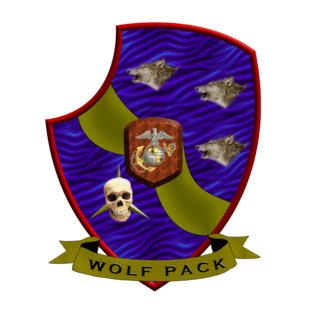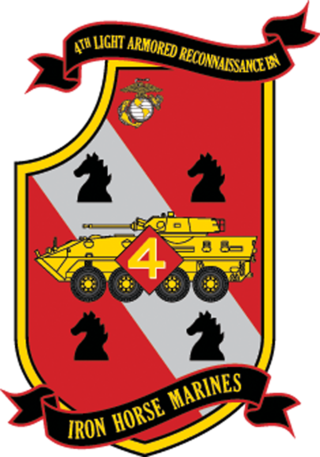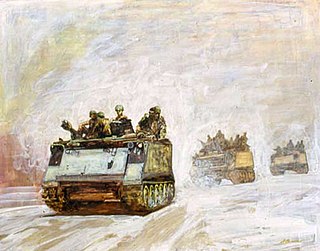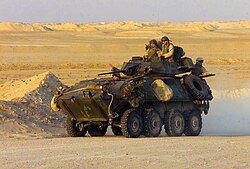
The Battle of 73 Easting was fought on 26 February 1991, during the Gulf War, between Coalition armored forces and Iraqi armored forces. It was named for a UTM north–south coordinate line that was used as a phase line by Coalition forces to measure their progress through the desert. The battle was later described by Lt. John Mecca, a participant, as "the last great tank battle of the 20th century." This battle took place several hours after another, smaller, tank battle at Al Busayyah.

The United States Marine Corps Reconnaissance Battalions are the special operations assets of Marine Air-Ground Task Force that provide division-level ground and amphibious reconnaissance to the Ground Combat Element within the United States Marine Corps. Division reconnaissance teams are employed to observe and report on enemy activity and other information of military significance in close operations. The Military Occupational Specialty code for Reconnaissance Marine is 0321.

The Battle of Norfolk was a tank battle fought on February 27, 1991, during the Persian Gulf War, between armored forces of the United States and United Kingdom, and those of the Iraqi Republican Guard in the Muthanna Province of southern Iraq. The primary participants were the U.S. 2nd Armored Division (Forward), 1st Infantry Division (Mechanized), and the Iraqi 18th Mechanized and 9th Armoured Brigades of the Republican Guard Tawakalna Mechanized Infantry Division along with elements from eleven other Iraqi divisions. The 2nd Armored Division (Forward) was assigned to the American 1st Infantry Division as its 3rd maneuver brigade due to the fact that one of its brigades was not deployed. The 2nd Armored Division (Forward)'s Task Force 1-41 Infantry would be the spearhead of VII Corps. The British 1st Armoured division was responsible for protecting the right flank of VII Corps, their main adversary being the Iraqi 52nd Armored Division and multiple infantry divisions. It was the final battle of the war before the unilateral ceasefire took effect.

The brigade combat team (BCT) is the basic deployable unit of maneuver in the U.S. Army. A brigade combat team consists of one combat arms branch maneuver brigade, and its assigned support and fire units. A brigade is normally commanded by a colonel (O-6) although in some cases a brigadier general (O-7) may assume command. A brigade combat team contains combat support and combat service support units necessary to sustain its operations. BCTs contain organic artillery training and support, received from the parent division artillery (DIVARTY). There are three types of brigade combat teams: infantry, Stryker, and armored.

1st Light Armored Reconnaissance Battalion is a fast and mobilized armored terrestrial reconnaissance battalion of the United States Marine Corps. Nicknamed the "Highlanders," their primary weapon system is the LAV-25 Light Armored Vehicle armed with the M242 25mm Bushmaster chain gun. They fall under the command of the 1st Marine Division and the I Marine Expeditionary Force. The unit is based out of the Marine Corps Base Camp Pendleton, California.

2nd Light Armored Reconnaissance Battalion is a fast and mobilized armored terrestrial reconnaissance battalion of the United States Marine Corps. Their primary weapon system is the 8-wheeled LAV-25 and they fall under the command of the 2nd Marine Division and II Marine Expeditionary Force. The unit is based out of the Marine Corps Base Camp Lejeune, North Carolina. The current mission statement of the battalion is: To perform combined arms reconnaissance and security missions in support of the Ground Combat Element (GCE) of a Marine Air-Ground Task Force (MAGTF). Its mission is to conduct reconnaissance, security and economy of force operations, and, within its capabilities, limited offensive or defensive operations that exploit the unit's mobility and firepower.

3d Light Armored Reconnaissance Battalion(3D LAR BN) is a fast and mobilized armored terrestrial reconnaissance battalion of the United States Marine Corps. Their primary weapon system is the LAV-25 and they are part of the 1st Marine Division and I Marine Expeditionary Force. The unit is based out of the Marine Corps Air Ground Combat Center Twentynine Palms, California.
Reconnaissance, surveillance, and target acquisition (RSTA) groups the tasks of reconnaissance, surveillance and target acquisition conducted by the Department of Defense. RSTA supports military operations at a strategic, operational, or tactical level, either by dedicated RSTA forces or those which possess the capability.
In the United States Marine Corps, a Marine Air–Ground Task Force is the principal organization for all missions across the range of military operations. MAGTFs are a balanced air–ground, combined arms task organization of Marine Corps forces under a single commander that is structured to accomplish a specific mission. The MAGTF was formalized by the publishing of Marine Corps Order 3120.3 in December 1963, "The Marine Corps in the National Defense, MCDP 1-0". It stated:
A Marine air–ground task force with separate air ground headquarters is normally formed for combat operations and training exercises in which substantial combat forces of both Marine aviation and Marine ground units are included in the task organization of participating Marine forces.

4th Light Armored Reconnaissance Battalion is a United States Marine Corps Light Armored Reconnaissance battalion of the Marine Corps Reserve. Their primary weapon system is the LAV-25 and they are part of the 4th Marine Division and Marine Forces Reserve. The unit headquarters is at Camp Pendleton, California, but other units in the battalion are located throughout the United States. 4th LAR Bn is the largest combat battalion in the Marine Corps, with 7 companies.

Armoured cavalry are military units using armoured fighting vehicles (AFVs) instead of horses. They began to replace horse cavalry in the heavy shock and the light reconnaissance, skirmishing and exploitation/pursuit roles in most armies commencing after the First World War. In that succeeding capacity, the obsolete name "cavalry" was retained.

The 194th Armored Brigade is a separate brigade of the US Army. All armor, cavalry, and armor and cavalry mechanic soldiers, and Marines in equivalent specialties, are trained by the 194th under the armor component of the Maneuver Center of Excellence at Fort Moore, Georgia, where the 194th has been garrisoned since 2012.
In the United States Marine Corps, the ground combat element (GCE) is the land force of a Marine Air-Ground Task Force (MAGTF). It provides power projection and force for the MAGTF.

A combined anti-armor team or combined arms assault team (CAAT) is an organization of a United States Marine Corps weapons company where one or more platoons are operated in a detached role to conduct reconnaissance missions and combat ground armored vehicles and air defense vehicles with heavy weapons systems. CAATs often use weapon systems such as M2 .50 caliber machine guns, Mk-19 grenade launchers, and anti-armor missile systems such as BGM-71 TOW missiles and FGM-148 Javelins.

The 106th Cavalry Regiment was a mechanized cavalry unit of the United States Army in World War II recognized for its outstanding action. The group was organized in 1921 as part of the Illinois National Guard and during the Spanish–American War and World War I was known as the 1st Regiment Illinois Volunteer Cavalry. It underwent a number of reorganizations before World War II. Like other Guard units during the inter-war years, the 106th held weekly or monthly drills and yearly training. Readiness for war in 1940 led to the mechanization of the unit and induction into federal service at Camp Livingston, Louisiana on 25 November 1940.

Armoured reconnaissance is the combination of terrestrial reconnaissance with armoured warfare by soldiers using tanks and wheeled or tracked armoured reconnaissance vehicles. While the mission of reconnaissance is to gather intelligence about the enemy with the use of reconnaissance vehicles, armoured reconnaissance adds the ability to fight for information, and to have an effect on and to shape the enemy through the performance of traditional armoured tasks.
The reconnaissance mission within the United States Marine Corps is divided into two distinct but complementary aspects; Marine Division Recon and Force Reconnaissance.
The United States Marine Corps Scout and Sniper companies and the Scouts (Tank) companies of the tank battalions were the first among the division's reconnaissance assets. They existed around the same exact moment when 1st and 2nd Marine Division were created. In 1941, each regiment had a scout and sniper platoon. They were assigned to the regimental Headquarters and Service Company. These companies were used in variety of tasks and, on occasion in severe combat, were used as "spare" rifle companies. When 6th Marine Division deactivated after the end of World War II, its recon assets also deactivated. Only the current Marine Division Recon Battalions that exist today hold history reference to the Scout and Sniper Companies.

Task Force 1-41 Infantry was a U.S. Army heavy battalion task force which took part in the Gulf War of January – March 1991. It was also known as Task Force Iron. Task Force 1-41 Infantry was the first coalition force to breach the Saudi Arabian border on 15 February 1991 and conduct ground combat operations in Iraq engaging in direct and indirect fire fights with the enemy on 17 February 1991. It was the spearhead of VII Corps. The Task Force served at the Battle of 73 Easting and the Battle of Norfolk where it was assigned to the U.S. 1st Infantry Division. It engaged and destroyed elements of 11 Iraqi divisions by the end of combat operations. This includes a significant role in the destruction of 4 Iraqi armored brigades at the Battle of Norfolk. Task Force 1-41 Infantry was awarded a Valorous Unit Award for its accomplishments during combat operations. It consisted primarily of the 1st Battalion, 41st Infantry Regiment, 3rd Battalion, 66th Armor Regiment, and the 4th Battalion, 3rd Field Artillery Regiment all being part of the 2nd Armored Division (Forward), based at Lucius D. Clay Kaserne, 24 kilometres (15 mi) north of Bremen, in the Federal Republic of Germany. Task Force 1-41 was commanded by Lieutenant Colonel James L. Hillman.



















